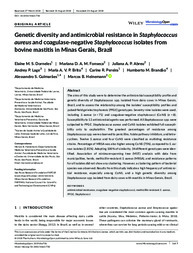Genetic diversity and antimicrobial resistance in Staphylococcus aureus and coagulase-negative Staphylococcus isolates from bovine mastitis in Minas Gerais, Brazil.
Genetic diversity and antimicrobial resistance in Staphylococcus aureus and coagulase-negative Staphylococcus isolates from bovine mastitis in Minas Gerais, Brazil.
Autoria: DORNELES, E. M. S.; FONSECA, M. D. A. M.; ABREU, J. A. P.; LAGE, A. P.; BRITO, M. A. V. P.; PEREIRA, C. R.; BRANDAO, H. de M.; GUIMARÃES, A. S.; HEINEMANN, M. B.
Resumo: The aims of this study were to determine the antimicrobial susceptibility profile and genetic diversity of Staphylococcus spp. isolated from dairy cows in Minas Gerais, Brazil, and to assess the relationship among the isolates? susceptibility profiles and pulsed‐field gel electrophoresis (PFGE) genotypes. Seventy‐nine isolates were used, including S. aureus (n = 71) and coagulase‐negative staphylococci (CoNS) (n = 8). Susceptibility to 12 antimicrobial agents was performed. All Staphylococcus spp. were subjected to PFGE. Staphylococcus aureus and CoNS isolates exhibited full susceptibility only to cephalothin. The greatest percentages of resistance among Staphylococcus spp. were observed to penicillins, folate pathway inhibitors, and tetracyclines. Twelve S. aureus and four CoNS were classified as multidrug resistance strains. Percentage of MRSA was also higher among CoNS (75%), compared to S. aureus isolates (2.81%). Adopting 100% of similarity, 34 different genotypes were identified. Association of minimum‐spanning tree (MST) analysis with data from municipalities, herds, methicillin‐resistant S. aureus (MRSA), and resistance patterns for all isolates did not show any clustering. However, a clustering pattern of bacterial species was observed. Results from this study indicate a high frequency of antimicrobial resistance, especially among CoNS, and a high genetic diversity among Staphylococcus spp. isolated from dairy cows with mastitis in Minas Gerais, Brazil.
Ano de publicação: 2019
Tipo de publicação: Artigo de periódico
Unidade: Embrapa Gado de Leite
Observações
1 - Por padrão são exibidas publicações dos últimos 20 anos. Para encontrar publicações mais antigas, configure o filtro ano de publicação, colocando o ano a partir do qual você deseja encontrar publicações. O filtro está na coluna da esquerda na busca acima.
2 - Para ler algumas publicações da Embrapa (apenas as que estão em formato ePub), é necessário ter, no celular ou computador, um desses softwares gratuitos. Sistemas Android: Google Play Livros; IOS: iBooks; Windows e Linux: software Calibre.
Acesse outras publicações
Acesse a Base de Dados da Pesquisa Agropecuária (BDPA) para consultar o acervo completo das bibliotecas da Embrapa.

